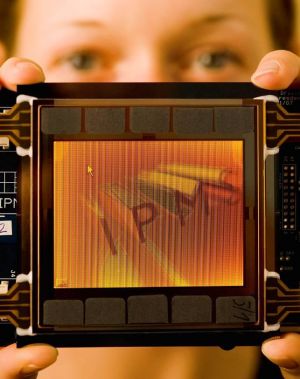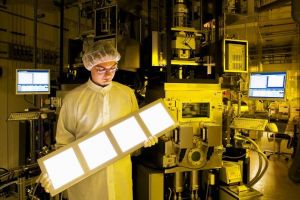Back to page 1
Q: You mentioned once an OLED pico-projector. Can you give some more info on that?
The OLED pico projector is a novel idea to use OLED micro-displays on CMOS-backplane for a new application. Based on the tremendous progress in OLED parameters within the last years, it is possible to realize high-brightness solutions.
Pico-Projectors for mobile devices are a big trend in the international market. LCOS displays, DLP or laser projection are the most prominent technologies in this field. Within the Fraunhofer IPMS we are also working in the field of MEMS scanner-based laser projection. We think that a highly efficient and high-brightness OLED microdisplay could be an interesting alternative by reducing the effort and size for the optics due to its direct emission.
We have already shown a first prototype during our opening of COMEDD and will continue to realize such high-brightness OLED solutions., e.g. within the above-mentioned HYPOLED project. Another side-market to high-brightness OLED microdisplays is related to see-through head-mounted displays (HMD). Employing an emissive OLED source for the display even allows to embed an additional camera on the same area (based on CMOS photodetectors in the silicon backplane), that is used for gaze-tracking, to finally achieve an interactive, eye-controlled HMD.
Q: Another project you are working on is 3D autostereoscopic displays with an OLED backlight. Why use OLEDs and not 'normal' LED backlighting?
The OLED backlight is patterned in stripes with individual control and driving, and based on additional special optics it is used together with an modulating LC panel to realize a full 3D system. Such backlight sub-patterning and integration could be only realized in simple manner by OLEDs, increasing efficiency of the 3D system and reducing the thickness of the whole system.
 3D-Display integration by patterned OLED backlight
3D-Display integration by patterned OLED backlightQ: You were involved in the OLLA project, and are also partners in the Oled100.eu project. What is your role in that project? Can you give us any updates?
In the OLLA as well as in the OLED100.eu project, the Fraunhofer IPMS is responsible for the large area fabrication technology and to realize the demonstrators. All large SM-OLED demonstrators shown in the OLLA project have been fabricated at the Fraunhofer IPMS. Within OLED100.eu our target is to realize a first 1x1 m² OLED panel and to develop the necessary fabrication technology. This work is based on the new COMEDD Gen2 fabrication line. We are now in the process installation phase and will show a first demonstrator rather soon.
 Large Area OLED lighting panel
Large Area OLED lighting panelQ: OLED lighting seems to be very promising these days. Everybody is working on it - in the US, EU and Asia. Who do you think will 'win' the race for the first OLED products? Do you think that Europe's several Project involving many companies and research institutes is the best way to go?
Of course, as a European institute we want that Europe win the race. The first OLED luminaire is already on the market, fabricated by Osram OS in conjunction with Ingo Maurer. To compete in this race we have to keep the pressure on the development and combine every competence in this field.
The combination of industrial, university, and institute resources is a good way to reach this, but it is necessary to avoid too small groups, you need larger groups to achieve fast progress. That’s one of the reasons to establish COMEDD, where we could establish the necessary equipment and human resources to be part in this race.
Q: Where do you see the lighting market in a few years?
We see first products for OLED lighting in 2009/2010, the solutions will be small and very expensive: However, prices will go down and the size will grow. To achieve real general lighting products, we have to still solve many fabrication and cost aspects. We thus expect that the start for general lighting solutions will not be before 2014/2015.
Q: Where do you see OLEDs in 5 years? When do you expect the first OLED lighting products to be 'commercially' available?
As it was already mentioned, the first lighting product is already on the market. New lighting production will start in 2009 and especially 2010. Small- and mid-size displays will probably have penetrated mobile consumer products at a considerable level. Emerging OLED applications beside displays and lighting might be foreseen, e.g., in optoelectronic sensors.
Prof Leo - thank you again for this great interview. I wish you and the Fraunhofer IPMS entire OLED program great success in the coming years. Hopefully your vision of OLED lighting will become a reality soon!

